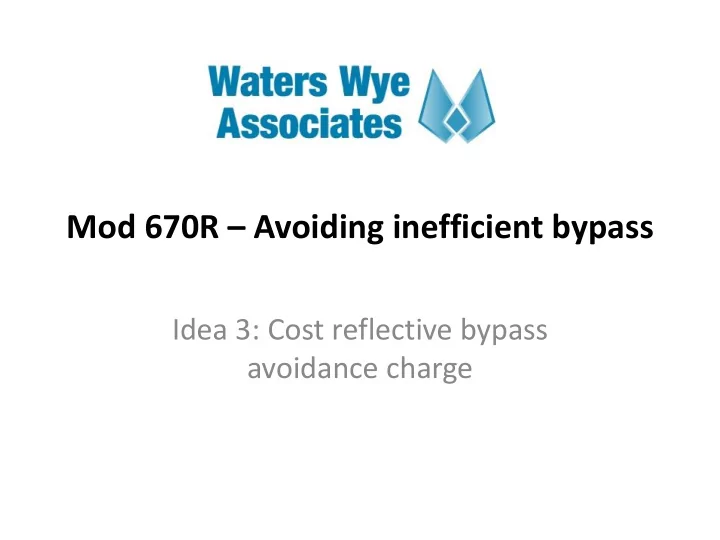

Mod 670R – Avoiding inefficient bypass Idea 3: Cost reflective bypass avoidance charge
Basis of idea The following elements have been considered in creating the idea • Creation of a capacity based charge for relevant routes • Based on a proxy of costs for building and maintaining a pipeline of a predefined distance (similar to the approach used currently) • Could be self-limiting, or include a distance cap • Not available to storage sites • User commitment through application process and non-use charges
Current Assumptions • A UNC 0621 Mod has been in effect since October 2019 that features: – CWD or Postage stamp RPC – No NTS Optional Charge exists after October 2021 • The RPC introduced does not reflect the costs of building or maintaining pipelines, it being focused on the allocation or allowed revenues • Yearly product • Technically available to all Users, except storage • The level of charge derived provides enough incentive to avoid inefficient bypass
Methodology Charge is intended to replace standard entry and exit capacity charges at applicable points. Approach 1 (as described in NTSCMF_Gas Charging Review_6 Nov 2017_ppt) Using current approach for determining OCC rate (underlying cost assumptions tbd) a) OCC Rate(p/kWh) X AQ (MNEPORx365) = Daily Pipeline cost (£) 365 b) Daily Pipeline Cost = Capacity Shorthaul Rate (p/kWh/day) Capacity Forecast (kWh/day) Capacity Charge allocated at Exit only, with no charge at entry? See later slide to guard against exploitation
Example (using Mod 621 model) • Entry Point Teesside • Exit Point Billingham ICI – MNEPOR (Baseline) = 43m kWh/d – FCC = 19m kWh/d – Distance = 8.7 km OCC Rate using current formula = 0.008198 p/kWh Daily Pipeline Cost = £3525 Shorthaul Capacity Rate = 0.00018 p/kWh/d If MNEPOR is booked, total Shorthaul Charge = £7,977 per day or £2.9m p/a • Without shorthaul using Mod 621 model – Teeside Entry = 0.0426 p/kWh/d – Billingham ICI = 0.0161 p/kWh/d • If MNEPOR is booked, total capacity charge = £25,241 per day or £9.2m p/a
Alternative approach • Approach 2 – Same as Approach 1, except total fee to recovered from shorthaul User is equivalent to Daily Cost of Pipeline – Daily Cost of Pipeline = Capacity shorthaul rate MNEPOR - User(s) required to book capacity equivalent to MNEPOR over the year - Where bookings are less than MNEPOR then additional fee applied - Note could use a p/kWh/km rate as an alternative
Example – Approch 2 • £3525/43m kWh/d = 0.000082 p/kw/d • Assume bookings = 32m kWh/d • Total capacity booking revenue = £2624 • Where bookings are less than MNEPOR, difference is paid by User at Exit Point – Difference to be paid by shorthaul users = £901 p/day
Prohibiting exploitation under either approach • As capacity bookings are not linked to flow, it would be possible to utilise entry capacity “allocated” for shorthaul purposes to be used more generally Entry Point Exit Point 40 kWh/d 40m kWh/d capacity Exit 21m kWh flow capacity booked linked to for shorthaul Entry shorthaul service NBP • Potential solution would be to link nominations between entry and exit point in order to assign shorthaul capacity • In the example, 21m kWh would be assigned shorthaul capacity, the remaining 19m kWh would be charged at standard entry capacity rates
Proposed assessment criteria • Consideration of underlying cost assessment for generating valuation of bypass pipeline • Consider need for distance cap • Comparison with non-cost based approaches (ideas 1 and 2) • Consider possibility of using a p/kWh/km for approach 2 • Review impacts on all users • Cross-check for compliance
Recommend
More recommend